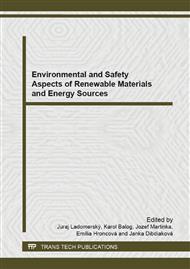p.90
p.94
p.103
p.109
p.114
p.118
p.126
p.131
p.141
The Environmental and Energy Potential of Incinerating Various Biomass Mixtures
Abstract:
In recent years, research has shown the advisability of seeking new types of biofuel. It has been shown that apart from one-component fuel, it is also advisable to use mixtures composed of basic raw materials. These mixtures may have a favourable effect upon the overall recovery of such fuels. This paper focuses upon options for the energy use of various mixtures of biomass waste. Biomass waste originates from primary agricultural production and countryside maintenance. This mainly consists of plant residues, i.e. straw and hay. Pellets were made using the given biomass. The pellets were prepared by mixing plant residues with spruce shavings as well as from pure materials, i.e. wheat straw, hay and sawdust. Individual types of biomass were mixed in various ratios: 50% wheat straw + 50% hay, 50% wheat straw + 50% sawdust, 50% hay + 50% sawdust, 33% wheat straw + 33% hay + 33% sawdust. The following basic parameters of the prepared samples were monitored: humidity, calorific value and ash content. These parameters influence the environmental as well as economic aspects of options for using these plant residues as fuel. It was discovered during the tests that the highest calorific value was achieved using a sample of biomass prepared by mixing 50% straw and 50% hay. The highest humidity was found in a sample of sawdust and the highest ash content in a sample prepared by mixing 50% straw and 50% hay.
Info:
Periodical:
Pages:
114-117
Citation:
Online since:
August 2014
Authors:
Keywords:
Price:
Сopyright:
© 2014 Trans Tech Publications Ltd. All Rights Reserved
Share:
Citation:


